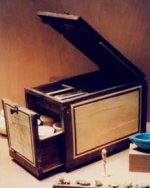I primarily use handtools in making period furniture, and would like to employ historically accurate methods -- as much as I can. I recall reading an article that C Schwarz penned about the three classes of sawcuts. It was interesting, but is that how the 18th C. cabinetmakers approached sawing? My limited education in this field is primarily drawn from forums such as this, much reading and research, and the kind assistance of many of you folks. I sometimes struggle with what I'm actually trying to do -- which is build high quality QA furniture using the methods of our forefathers. I don't want to be sloppy, but neither do I want to waste time chiseling out a scribed line on a tenon shoulder if that's not how it was done originally.
I try not to obsess about tools, and make every effort to keep their number in check. I have a mix of modern handtools (Adria saws, LV router, for instance), very old ones (moulding planes, brace, etc.), and ones I've made myself (squares, gauges, hammers, etc.) so I'm not trying to be a "re-enactor" or fundamentalist when it comes to making furniture. I just want to approach it with a similar mindset: the piece is the goal -- turning it out cleanly and efficiently. Which handtools are used in the process is of far less consequence to me. And using them in a fashion that seeks far too much accuracy is a pitfall I want to avoid.
Your thoughts and ideas are much appreciated.
Allan
I try not to obsess about tools, and make every effort to keep their number in check. I have a mix of modern handtools (Adria saws, LV router, for instance), very old ones (moulding planes, brace, etc.), and ones I've made myself (squares, gauges, hammers, etc.) so I'm not trying to be a "re-enactor" or fundamentalist when it comes to making furniture. I just want to approach it with a similar mindset: the piece is the goal -- turning it out cleanly and efficiently. Which handtools are used in the process is of far less consequence to me. And using them in a fashion that seeks far too much accuracy is a pitfall I want to avoid.
Your thoughts and ideas are much appreciated.
Allan

